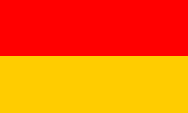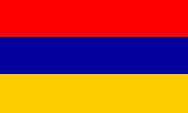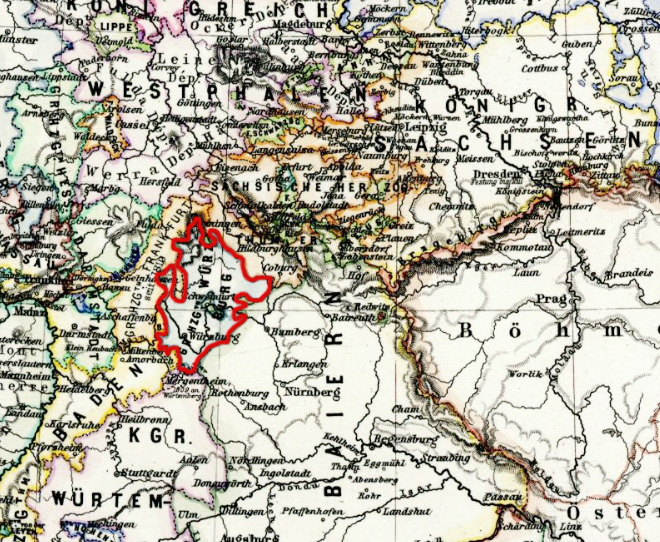mobile View, to the German Version tap the flag


- to 1803 Bishopric
- 1805–1806 Electorate
- 1806–1814 Grand Duchy
- from 1806 Member of the Rhine Confederation
• Flags
• Meaning/Origin of the Flag
• Coat of Arms
• Meaning/Origin of the Coat of Arms
• Map
• Numbers and Facts
• History
• Origin of the Country's Name

1805–1806,
Flag of the Electorate of Würzburg,
Source, by: World Statesmen




1806–1814,
Flag of the Grand Duchy of Würzburg,
Source, by: World Statesmen





Yellow and red are the colors of the City of Würzburg, which were also used by the Diocese of Würzburg. The diocese was abolished in 1803 on the occasion of the German Mediatisation and its territory became mostly annexed to the Electorate of Bavaria. In 1805 (Treaty of Pressburg) Würzburg came from Bavaria to Ferdinand of Habsburg, who had the title of an Elector. Bavaria received Tyrolia for compensation. Würzburg joined in 1806 the Rhine Confederation, the Elector has to renounce its title, but in this way Würzburg became levied to a Grand Duchy. The flag has been changed and there was added a blue stripe between the red and the yellow stripe. The colours are a combination of the colors of the former diocese and the colours of the City of Würzburg.
Source: Volker Preuß


Coat of arms of the City of Wuerzburg,
Source, by:
Wikipedia (DE)

Coat of arms of the Bishopric of Wuerzburg,
Source, by:
Wikipedia (DE)

Coat of arms of the Grand Duchy of Wuerzburg,
Source, by:
Wikipedia (DE)

The coat of arms of the City of Würzburg shows a so-called "race flag" in the colours red and yellow on a black shield. The race flag commemorates the coat of arms of the Diocese of Würzburg, but there are displayed the colors red and white, the colours of Franconia. The bishops of Würzburg were from the 12th century nominally also Dukes of Franconia. In 1805 (Peace-Treaty of Pressburg) Bavaria ceded Würzburg to Ferdinand of Habsburg, who had the title of an Elector. In this way was made the Electorate of Würzburg. Now the Austrian tie shield was placed in the middle of the coat of arms of the former Diocese of Würzburg, surmounted by a crown of a Prince. When the country became a Grand Duchy in 1806, the coat of arms was retained.
Source:
Wikipedia (D),
Volker Preuß


Source: Hand-Atlas für die Geschichte des Mittelalters und die neueren Zeit von Spruner and Menke,
modyfied by: Volker Preuß
The map shows the Grand Duchy of Würzburg between the years 1810 and 1813, within a red border.

Area: ca. 2 300 square miles
Inhabitants: not known
Capital: Würzburg
official Language: German
Currency: not known
Source:
Wikipedia (D)

741 · founding of the Bishopric of Würzburg
1168 · the Bishops of Würzburg become appointed to Dukes of Eastern Franconia
1792, 1796, 1800 and 1805 · invasions of French revolutionary troops under Napoleon in the German Empire, the German Empire subjectes and becomes territorially transformed
1801 · all left-bank territories of the River Rhine ceded to France, and incorporated by this
1803 · German Mediatisation (Reichsdeputationshauptschluss), transformation of the territorial partition of the German Empire, ecclesiastical possessions become confiscated, old princely territories and free cities become confiscated or dissolved or annexed to old or new principalities, the number of sovereign authorities and territorial entities of the empire is thus reduced from 300 to 60 – the Diocese and Bishopric of Würzburg becomes abolished and its territory is given largely to the Electorate of Bavaria
26th of December in 1805 · Peace of Pressburg, Bavaria receives Tyrolia and cedes in return Würzburg to Ferdinand Joseph of Habsburg (former Grand Duke of Tuscany), even because he renounces the Electorate of Salzburg, he could keep the Elector title, and this becomes tranferred to Würzburg - rise of the Electorate of Würzburg
12th of July in 1806 · Napoleon forces the creation of the Rhine Confederation, an alliance of sixteen southern and southwestern German states under French protectorate
1st of August 1806 · the states of the Rhine Confederation declare themselves sovereign and resign from the Holy Roman Empire of German Nation
6th of August in 1806 · Emperor Franz II. lays down the crown of the Holy Roman Empire of German Nation, the empire ends
26th of September in 1806 · Ferdinand Joseph joins the Rhine Confederation, thereby he lays down the title of an Elector and becomes appointed ta a Grand Duke - rise of the Grand Duchy of Würzburg
October 1813 · Napoleon's defeat at Leipzig, the Rhine Confederation starts to desintegrate
1st of May in 1814 · Würzburg becomes annexed to Bavaria, the Grand Duchy ends
1815 · Congress of Vienna, reconstruction of Europe after the era of Napoleon, the ownership and the administrative partitions in the former German Empire become restored, but not the sovereignty of the ecclesiastical countries, their possessions become transferred to old or new principalities, Joseph Ferdinand, the former Grand Duke of Würzburg gets the Tuscany back, the 39 remaining German states become organized in a loose association, the German Confederation
Source:
Wikipedia (D),
World Statesmen

The name "Würzburg" comes from a settlement called "Virteburg" on the river Main. The word "virt" or "wirt" means "protector".
Source:
Handbuch der geographischen Namen


![]()







